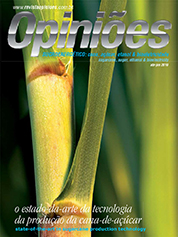Jorge Luis Donzelli
Development Coordinator of the Agronomy Program of CTC
Op-AA-24
Edaphoclimatic sugarcane production environments
Nowadays, when one talks of “Production En-vironments” and about the allocation of varieties at technical meetings in the sugarcane industry, this sounds like something perfectly normal. The term has become jargon, as one may say. But this was not always so. Back in 1981/1982, when the CTC - Sugarcane Technology Center, headquartered in the City of Piracicaba, decided to pioneer investments in soil charts of its associated members, the terms and the names of soils used at the time sounded to users like difficult names to pronounce or even to understand.
The names of soils created by the former National Commission of Soil Surveys, nowadays incorporated in Embrapa, has the objective of well representing the soil categories according to their genesis and morphology. However, in CTC this language universe aimed at scientists and researchers needed to be disseminated in the field in a simple manner, while not losing its scientific origin.
Consequently, together with the work of soil mapping, a revolution started to approximate the end user and the nomenclature of the different existing soils, in a clear and easy to under-stand manner. One therefore created a Soil Classification Key, common to all users, so that a soil type could be identified by a simple and unique acronym. From this time onwards, Soil Charts of all associated members were registered in a common database, which al-lowed for the creation of a database on sugarcane production, currently one of the most complete in the world.
In the middle of 1992, an important research opportunity arose when a group of soil researchers of CTC began studies to interpret the detailed soil maps for specific use with sugarcane, using this very large database. This work resulted in the first version of a specific land for sugarcane plantation classification system in Brazil, called Production Environments.
The more than 300 types of soil identified in association members are now grouped in five categories (Production Environments) - “A”, “B”, “C”, “D” and “E” – allowing variety planning and communication among planners of units associated with CTC. Thereby it is possible to correctly allocate sugarcane varieties and achieve the maximum genetic potential they encompass.
This concept was publicized in the 6th and 7th Agronomy Technology Seminars of Copersucar, respectively in 1994 and 1997. The CTC method was quickly adopted by associated members and a few years later it was also incorporated in universities and other research institutes of the State of São Paulo and Brazil, which acknowledged the technology.
In the 2002/2003 harvest, CTC began studies on productivity as a function not only of soil, but also of climate. Based on such studies, in the 2008/2009 harvest, a second generation of Production Environments was created, called Edaphoclimatic Production Environments, which collects information on soil and climate in the same base.
The varieties produced by the Genetic Improvement Program of the CTC were selected in specific edaphoclimatic production environments for the main regions in which sugarcane is pro-duced or is planned to be produced in Brazil. With this technological level, CTC associated members become more productive by the day, given that sugarcane varieties are specific for each edaphoclimatic region.
Work is continuing. In the 2008/2009 harvest, due to the large demand for such strategic information, given that land availability was becoming rare, CTC organized a team comprising eight engineers, specialists in soil, who perform full-time in the country’s main sugarcane regions.
Currently, the area set aside for the elaboration of the Soil and Edaphoclimatic Production Environments Chart, within this program, totals about 4,500,000 ha, but may increase in coming years, depending on the industry’s growth. CTC specialists have already map-ped about 1.6 million hectares of sugarcane, 700,000 of which in the most recent harvests alone.
The soil charts, along with the associated members’ technological indices, collected in several harvests, constitute the country’s largest database, showing agricultural productivity of various sugarcane species, technological indices, types of soil and Production Environments. A scoring for the CTC. An achievement of its associated members that once again are a step ahead in terms of agricultural technology in the sugar-based energy industry.




